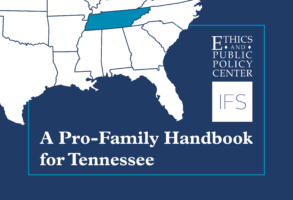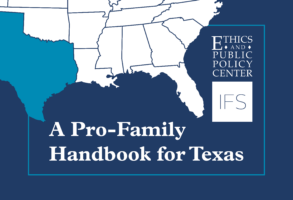Patrick T. Brown
Fellow
Patrick T. Brown is a fellow at the Ethics and Public Policy Center, where his work with the Life and Family Initiative focuses on developing a robust pro-family economic agenda and supporting families as the cornerstone of a healthy and flourishing society.
Patrick T. Brown is a fellow at the Ethics and Public Policy Center, where his work focuses on developing a robust pro-family economic agenda and supporting families as the cornerstone of a healthy and flourishing society.
His writing has been published in The New York Times, National Review, Politico, The Washington Post, and USA Today, and he has spoken on college campuses and Capitol Hill on topics from welfare reform to child-care and education policy.
He has published reports on paid leave and family policy with the Institute for Family Studies, and edited an essay series featuring working-class voices for American Compass. He is an advisory board member of Humanity Forward and the Center on Child and Family Policy and a contributing editor to Public Discourse.
Prior to joining EPPC, Patrick served as a senior policy advisor to Congress’ Joint Economic Committee. There, he helped lead research about how to make it more affordable to raise a family and more effectively invest in youth and young adults. He also previously worked a government-relations staffer for Catholic Charities USA.
Patrick graduated from the University of Notre Dame with a degree in political science and economics. He also holds a Master’s in Public Affairs from Princeton University’s Woodrow Wilson School of Public and International Affairs. He and his wife Jessica have four young children and live in Columbia, S.C.
How America Became ‘Family Unfriendly’
Patrick T. Brown

Tim Carney’s new book envisions an alternative to modern helicopter parenting.
Articles
The Dispatch / March 23, 2024
Hur hearing shows GOP will need more than age issue against Biden
Patrick T. Brown

If Republicans were hoping that Hur’s testimony would do their political heavy lifting for them, they will have to think again.
Articles
CNN / March 21, 2024
Smaller families, longer lives: Are we ready for the coming senior care crisis?
Patrick T. Brown

The way they face the end of life, and the choices we opt to prioritize or make available, will set the script for how we treat death, the labor of caretaking, and the value of human dignity into the future.
Articles
Angelus / March 20, 2024
The path forward on IVF
Patrick T. Brown

Reproductive technology should not be a way to radically remake family structure.
Articles
Deseret News / March 2, 2024
EPPC Scholars Sign Joint Letter to State Legislatures Urging Action on Tech Policy
Patrick T. Brown

On February 15, EPPC scholars Patrick T. Brown and Clare Morell signed a joint letter with Brad Wilcox and Michael…
PDF / February 21, 2024
A Pro-Family Handbook for Georgia
Patrick T. Brown

Introduction Georgia is helping the Sun Belt become an economic powerhouse. With one of the nation’s most dynamic major metro…
PDF / February 1, 2024
A Pro-Family Handbook for Tennessee
Patrick T. Brown

Introduction The strength of a state is the strength of its families. Tennessee’s recent growth, dynamism, and promise has made…
PDF / February 1, 2024
A Pro-Family Handbook for North Carolina
Patrick T. Brown

Introduction The secret is getting out—North Carolina has emerged as one of the best states for families. The Tar Heel…
PDF / February 1, 2024
A Pro-Family Handbook for Texas
Patrick T. Brown

Introduction Everything is bigger in Texas—including its success in attracting families, its economic dynamism, and its potential to provide parents…
PDF / February 1, 2024
A Child Tax Credit Compromise for the Real World
Patrick T. Brown

The Wyden-Smith deal focuses specifically on families who make too little to benefit from the full amount of the CTC, particularly those with more than one child.
Articles
The Dispatch / January 30, 2024
Natalism Is Not Enough
Patrick T. Brown

Even secular natalists should be concerned about the empty pews, because marriage remains a very strong predictor of fertility.
Articles
National Review / January 25, 2024
What Journalists Get Right and Wrong About Declining Fertility
Patrick T. Brown

Perhaps the biggest change in American fertility since the Great Recession is that women without a college degree are now putting off having a child just like their college-educated peers have for decades.
Articles
Institute for Family Studies / January 24, 2024
There’s plenty of science fiction available to stream on Netflix, but perhaps few scenes seem as fanciful to today’s young viewers as the four tweens of Stranger Things riding their bikes around—unsupervised.
The canonical American kid on a bike, meeting up with others to start a pickup baseball game or visiting each other’s houses, haunts Tim Carney’s new book, Family Unfriendly: How Our Culture Made Raising Kids Much Harder Than It Needs to Be. If American childhood was a little more free-range, Carney argues, America’s fertility crisis would feel a lot more solvable. In such a world, many couples might feel a little more comfortable having a child—or more than one—and our culture might be more receptive to this compelling vision of what family can be.
Carney’s book covers a wide array of settings and topics, from the kindergartens of Tel Aviv to debates over feminism and “having it all.” Much like his previous book, Alienated America, his work blends salt-of-the-earth journalistic reporting with a keen sense of sociological trends. It’s shot through with affection for his neighborhood, love for his church, gratitude for his family, and more than a little bit of Gen X nostalgia. The fond (though not oversentimental) picture Carney paints in the book buttresses his vision of a society in which children are more celebrated, present, and welcomed. It’s still early in the year, but Family Unfriendly may be the most essential read of 2024.
Most of the first part of the book articulates its overarching thesis—that birth rates have declined because parents set the bar too high. The second part broadly deals with the structural factors that have made society feel designed for the needs of the individual rather than the family as a unit. This sense can be felt from unaffordable housing and unwalkable streets to a cultural neo-Victorian sense that children should be neither seen nor heard. The last third delves into deeper questions of human nature, vocation, sex, and technology, attempting to grapple with what changed about human nature to make kids seem like a threat rather than a natural part of one’s adulthood.
“Every pro-family change we need,” Carney writes, “requires making things messier, giving up control … giving up on the individualistic, self-determined, autonomy-centered religion of independence (whether feminist, workist, or capitalist) also means embracing a more fertile life.”
This is most visible in the white-knuckle, high-intensity attitude toward having children that treats “parenting” as an active verb, rather than a passive state. The casual parenting techniques of the “latchkey kid” generation seem like science fiction today. Carney laments that in this age of helicopter parenting, kids aren’t turned outside with the admonition to “come home when it gets dark,” robbing them of the ability to develop self-sufficiency. Moreover, he worries these parenting trends place more burdens on mom and dad to oversee constant human capital formation.
Part of this is an outgrowth of a wealthier society with more opportunities than ever before. As incomes rise, more people become more able to afford private violin tutors, pitching coaches for 9-year-olds, pricey daycares or private schools, and all the other high-intensity practices that Carney decries. Parents who want what’s “best” for their kid, he writes, unthinkingly adopt a definition of “best” that means “most likely to get your kid into the Ivies.”
But not all the increase in parental time and investment is in search of college scholarships. Hands-on parenthood doubtless led to safer childhoods. Even with the post-COVID uptick in traffic fatalities, the number of children under 13 killed as pedestrians fell by more than 90 percent since the mid-1970s. The number of child fatalities is about half what it was before states adopted car seat requirements. In 1982, 212 children nationwide were abducted and murdered by strangers; by 2011, that number had fallen into the single digits. Rates of substantiated child sexual abuse dropped from over 23 cases per 10,000 kids as recently as 1990 to fewer than eight last year. By these metrics, there’s never been a safer, healthier, and more prosperous time to grow up as a child than in 21st-century America.
Then why are kids—and their parents—not all right? Teen anxiety continues to rise, partly due to social media and smartphones but also due to the excessive pressure of a hyper-meritocratic approach to childhood. There’s little question that the pressure many parents put on themselves to be full-time concierge, chauffeur, butler, personal chef, and guidance counselor makes American parenting less fun than it could be. While somewhat speculative, it doesn’t take much of a logical jump to imagine that the “rug rat race” is at least partly responsible for the decline in birth rates seen in the U.S. and abroad.
The solution Carney proposes is to care a little less about children’s material outcomes (after all, if demographic trends hold, future generations will find it much easier to get into top-ranked colleges anyway.) He wants more frequent but less formal social gatherings—Carney agrees with a former first lady who said that “it takes a village” to raise a child—and to give parents the needed space for juggling their various responsibilities. With plenty of both personal experience (as a dad of six) and social science research under his belt, Carney argues that a society that does not intentionally build infrastructure and institutions with families in mind inevitably runs the risk of excluding them.
As with any discussion about family and fertility, it’s helpful to distinguish possible changes that could help people have more kids from the interventions that could make life a little easier for existing parents. The debate over if and how pro-natal tax and spending incentives work is a complicated one. They don’t seem to work especially well, and the ones that do tend to be expensive.
But the U.S. hasn’t even neared the point of being able to claim we’ve tried everything. We should experiment more, particularly in urban design, child care spending, labor policy, tech regulation, and the other areas Carney highlights. And moving the gears of government in a more pro-parent direction—and thus relieving them of some of the intense pressure many say they feel—could help lead to more births overall.
Though it covers a lot of terrain, Family Unfriendly most vividly reflects the pressures facing middle-and-upper class couples. His depiction of the modern pressure cooker of parenthood seems to hit the target most squarely when considering the Varsity Blues scandal or other competitions high-income parents put themselves through in pursuit of the coveted Ivy League bumper sticker for their hybrid.
Working-class parents surely experience some of these expectations, particularly since having fewer kids around creates a sort of feedback loop: fewer kids means fewer family-friendly institutions and infrastructure for kids. But travel sports leagues or climate anxieties aren’t universal experiences. While dead-on, Carney’s critiques of an upwardly aspirational sensibility may not describe the decline of childbearing outside major metro areas. And for non-Gen Xers, Carney’s portrait of the halcyon age of kids roaming suburbs on bikes may feel overly rosy.
More fundamentally, there’s a big challenge facing Carney’s vision of detached parenting, free-range childhood, and a less-work-centric family: the broader social trend toward secularization and singlehood. A Utah couple Carney interviews explains their child-free choice by saying, “Some people are watching Teletubbies and cleaning up vomit, and we’re going to be drinking margaritas in Paris.”
The couple is striking for their honesty as much as their short-sightedness. (Who goes to Paris to drink a margarita?) They typify an America that is becoming less churched and less married-off, particularly among adults without a college degree. The problem with Carney’s hale, hearty, and desirable vision for community life may be that it relies on social capital muscles that are quickly atrophying.
As he writes, Americans are increasingly choosing independence over attachment, seeing marriage as a lifestyle choice like any other—or, at best, a “graduation” from young adulthood—rather than the foundational unit of a healthy society. Having more young adults marry, and marry sooner, would likely go a long way to creating the streets full of kids roaming on bicycles he wishes for.
Solving America’s fertility crisis means a revitalization of family, faith, and neighborhood along the lines Carney explores in Family Unfriendly. A healthier society would debate Carney’s thesis with the same vigor as special counsels and presidential senility tests. In the interim, we’ll have to settle for encouraging Carney’s vision of the family to be taken seriously and read widely.